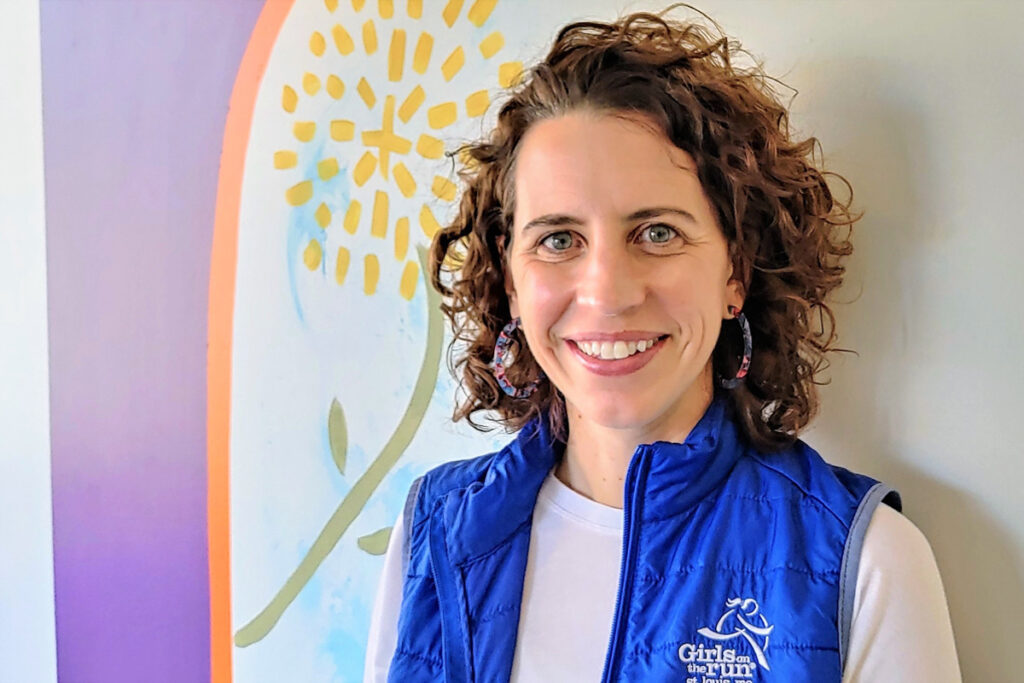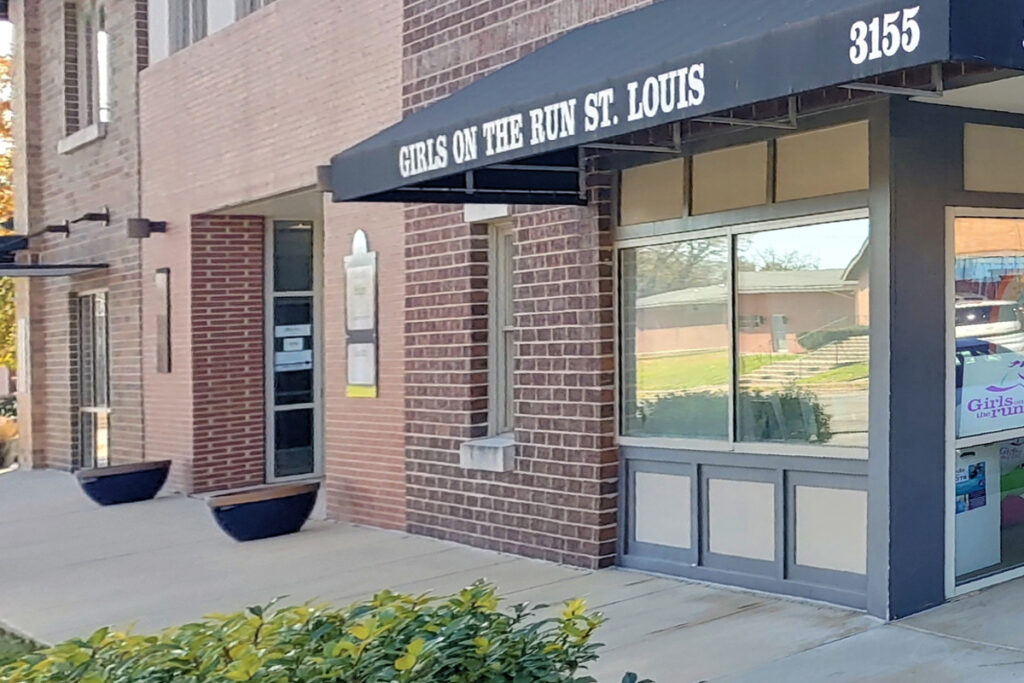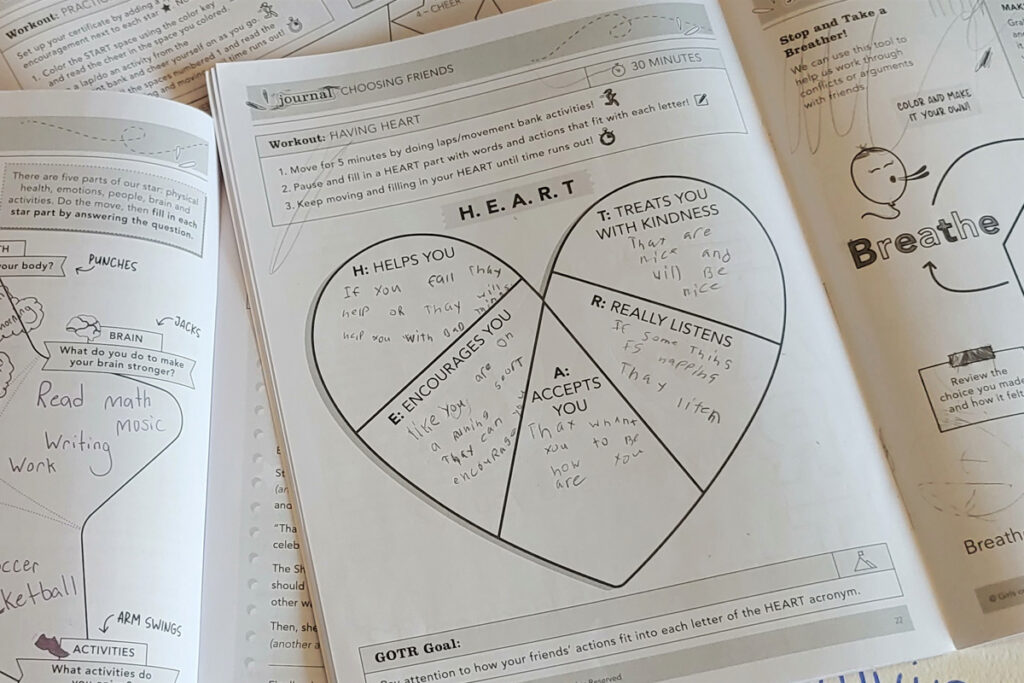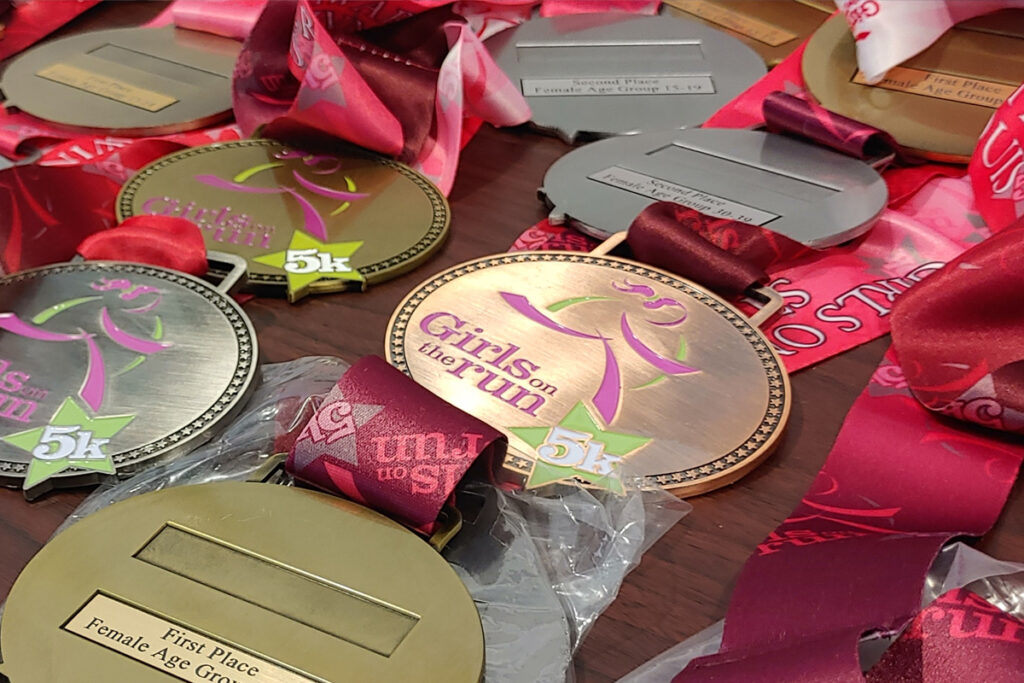Widespread research suggests that most girls stop feeling good about themselves by their teens. Girls on the Run (GOTR) works to counteract this through evidence-based programming that marries social and emotional learning with physical activity. The international organization strives to create positive experiences for girls in grades 3-8.

While the pronouns “she” and “her” will be used throughout this story, Girls on the Run-St. Louis Executive Director Courtney Berg notes that GOTR-STL views gender as a spectrum and will work with kids who identify on that spectrum.
GOTR-STL started in 2002, when St. Louis mother Jill Indovino read an article in Runner’s World magazine about Molly Barker, who founded the organization in North Carolina. Jill started the St. Louis program with 20 girls meeting at a park bench in Clayton’s Shaw Park. Today, GOTR-STL is one of the largest of 200 councils in North America; the program operates in more than 500 schools and community sites in 23 counties in eastern Missouri and western Illinois.
Courtney says a basic impact study has shown that 97 percent of the girls—in one season—show growth in self-esteem, body-size satisfaction, and commitment to physical activity as a preventative measure. She says GOTR girls continue to outperform other girls in the same community even five years later.
Listening to the community

Approaching a new school or community site starts with data and conversations that involve mostly listening. Courtney and her staff look for areas where the data shows gaps in health and economic wellbeing—unemployment rates have become more important during the pandemic—before reaching out to a potential site.
Courtney says going into a community with the message of “you need this” is the antithesis of community work. She says the relationship begins with listening to ground-level truth regarding their strengths and what they want to build upon. “We may or may not be part of their plan, but we’re there to listen,” she says.
Although GOTR-STL works across many diverse schools and settings, Courtney avoids explaining the breadth of the organization’s experience to new sites. When a principal says their school is different, she tells them sincerely, “You are absolutely right. Tell me about your school. Tell me about your community. Tell me about the girls. Tell me what your last school year has been. I need to hear about that.”
School leaders or parents who have heard about or been involved in the program in other locations often reach out to GOTR to start a new program site. Courtney shares, “One of the biggest things I have learned as a social worker is you can’t leverage a relationship until you have a relationship.”
In 2020, St. Louis Public Schools stopped offering after-school programs, forcing GOTR-STL to focus on community sites, which had long been a challenge. Courtney says, “I’ll be honest, that really weighed on me. Where is she and what’s happening? The pandemic forced us to completely open up and look at how we were doing it.” GOTR-STL began working with The SoulFisher Ministries and an Urban League social worker embedded in a St. Louis Public School, both trying to provide extracurricular support to children at a time when schools were entirely virtual. These relationships have led to delivering the program to more schools.
Removing the logs
Courtney says her job is remove barriers for her staff and the girls—to “drive down the road, move the logs, and let them run.” This year, she says, “There’s more logs.”
The operational cost of a season per girl is $175. GOTR-STL offers a sliding scale fee, payment plans, and scholarships. The fees are adjusted based on data modeling specific to each community. With uncertainty about schools at the end of 2020, GOTR-STL decided to give scholarships to all participants. It anticipated 500 girls would sign up, but ended up with over twice that number. Courtney says the overwhelming response identified the level of need and confirmed for her it was the right decision.
GOTR gives every girl a t-shirt and, if needed, a practice outfit. They partner with Big River Running Company to ensure each girl has properly fitting running shoes.
GOTR-STL knows many of its girls score high on the Adverse Childhood Experiences (ACE) questionnaire, a survey of childhood trauma and its impact on future psychological and medical wellbeing. Courtney says, “Study over study has told us that one of the most powerful interventions you can do for a kiddo with a high ACE score is one positive, consistent adult. Let’s get a positive, consistent adult in her life for eight weeks.” Many of the coaches are already part of the schools the girls attend.
Mastery, not performance
The 8-week GOTR curriculum focuses on individual growth and equipping each girl to feel confident in setting her personal goals, number of laps or to practice a new strategy. The girls are each given a bracelet to count laps, but coaches and teams have also been creative. Some have applied a different color of nail polish at each lap or written out a self-affirming message on a girl’s arm by adding a letter per lap.

In 2020, GOTR began providing journals that follow along with the curriculum. The girls are asked to write down how many laps they expect to do. At the end of the exercise, the coaches can talk to the girls about those expectations. Courtney says, “A lot of times the girls will say, ‘Well, I only ran two and I walked three.’” She points out to them, “No, you did five.”
Practice times are determined by each team. Courtney says a typical practice begins with snacks and an exercise to get the “wiggles” out.
Next, a guided activity recalls previous lessons. A movement is then looped back to that activity. A coach may tell a girl to run to another coach, who has a card with a feeling written on it, then return and say whether they feel comfortable with that feeling. Guided questions are then asked to help the girls process those feelings.
A new concept and activity are added, followed by a wrap-up discussion and energy awards. The awards, given by both coaches and other teammates, take the form of a short cheer with a movement and are given to girls who said or behaved in a way that was encouraging that day. (See a video of energy awards)
The GOTR program culminates in a non-competitive 5K in the spring and the fall, the largest in Missouri and tenth largest in the country. Transportation for the girls and their families is available, as Courtney says, “So somebody can run with her—somebody in her life—because that is a powerful moment. They get to watch her. At some point, in those 3.1 miles, she becomes the expert.”

The fall 5K was held on Nov. 13 in Forest Park. Courtney says, “Seeing our community come together again to celebrate the strength and resiliency of every girl on the run—and our connectedness as a community—it was incredible!” Next year, the spring event will also be held in Forest Park on May 14.
Courtney says GOTR is focused on the long game. She looks forward to the girls taking major roles in society addressing issues such as gender-equity and the gender pay gap. “I’m ready for a girl on the run to be my boss … our next mayor. These are the women we’re ready for.”
To see Girls on the Run St. Louis in action during the Spring 2021 season, watch this video.